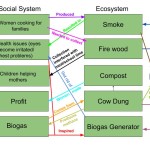- System Diagram
My system diagram presented shows the effect how the new and old ways for cooking has on the social system and the surrounding ecosystem. The arrows show the impact on that particular topic. The diagram shows the positive and negative aspects for using each fuel source. The negative impacts shown are related to using sticks for a fuel source by decreasing health and using child labor. The biogas fuel shows the positive impacts on the social system and ecosystem. The biogas fuel eliminated the need for child labor and has less health concerns. Also, the biogas fuel has helped their economy by selling compost that was made from the waste of the biogas food to the local farmers for fertilizer. This diagram also shows the biogas fuel has more resilience over the old fuel by, not having to depend on sticks and child labor.
When comparing my diagram to Figure 1.5 in the “What is Human Ecology?” article, there are similarities and differences. Both diagrams highlight the components of the social system and ecosystem. Also, both have the same general idea of the human-environment system and how they impact each other. Both show the different components of the biogas fuel and uses of its byproducts. The differences of the two diagrams is that in the Marten’s diagram, it uses the overall population, where in mine, I broke it down into the women and the child labor aspects. Comparing the two diagrams showed how there can be different perspectives and interpretations. Both diagrams highlight the main concepts that were discussed during the video.


